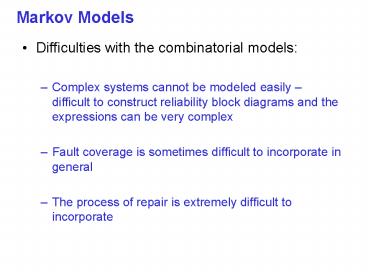Markov Models PowerPoint PPT Presentation
1 / 37
Title: Markov Models
1
Markov Models
- Difficulties with the combinatorial models
- Complex systems cannot be modeled easily
difficult to construct reliability block diagrams
and the expressions can be very complex - Fault coverage is sometimes difficult to
incorporate in general - The process of repair is extremely difficult to
incorporate
2
- Two main concepts in the Markov model
- System state
- State transition
- For reliability models, each state of the Markov
model represents a distinct combination of faulty
and fault-free modules. - The state transitions govern the changes of state
that occur within a system
3
- Several assumptions made to construct transitions
for this example - System does not contain repair permanent faults
- Only one fault can occur at a time
- The system starts in the perfect state
4
Example
- Markov Model
- Reliability of TMR system
- A B C 1 Good 0 Faulty
- 1 1 1 (3 Good)
- 1 1 0 (2 Good / 1 Faulty)
- 1 0 1 (2 Good / 1 Faulty)
- 1 0 0 (1 Good / 2 Faulty)
- 0 1 1 (2 Good / 1 Faulty)
- 0 1 0 (1 Good / 2 Faulty)
- 0 0 1 (1 Good / 2 Faulty)
- 0 0 0 (3 Faulty)
5
(No Transcript)
6
Markov Model of the TMR system showing possible
states, State transition, and state transition
probabilities
7
- P3(t?t) (1-3??t)P3(t)
- P2(t?t) (3??t)P3(t) (1-2??t)P2(t)
- PF(t?t) (2??t)P2(t) PF(t)
Reduced Markov Model of the TMR system with a
minimal Number of states
8
- P3(t?t) 1- 3??t 0 0
P3(t) - P2(t?t) 3??t (1-2??t) 0
P2(t) - PF(t?t) 0
2??t 1 PF(t) - P(t?t) AP(t)
- P3(t?t)
- P(t?t) P2(t?t)
- PF(t?t)
- (1-3 ??t) 0 0
- A 3 ??t (1-2 ??t) 0
- 0 2 ??t 1
9
- P(?t) AP(0)
- P(?t ?t) AP(?t) AAP(0)
- P(n?t) AA..AP(0) AnP(0)
- P(n?t) AnP(0)
- P3(t) P2(t) PF(t) 1
- RTMR(t) 1 PF(t) P3(t) P2(t)
- P3(0) 1
- P2(0) 0
- PF(0) 0
10
- Continuous-Time
- P3(t ?t) - P3(t)
- -------------------- -3 ? P3(t)
- ?t
- P2(t ?t) - P2(t)
- -------------------- 3 ? P3(t) -2 ? P2(t)
- ?t
- PF(t ?t) - PF(t)
- -------------------- 2 ? P2(t)
- ?t
- dp3(t)
- -------- -3 ? P3(t)
- dt
11
- sP3(s) p3(0) -3?P3(s)
- sP2(s) p2(0) 3?P3(s) - 2?P2(s)
- sPF(s) pF(0) 2?P2(s)
- P3(s) 1 / ( s3?)
- P2(s) 3? / ((s2?)(s3?))
- PF(s) 6 ?2 / (s(s2 ?)(s3 ?))
12
- P3(s) 1 / ( s3?)
- P2(s) (3/(s2?)) (-3/(s3?))
- PF(s) 1/s (-3/(s2 ?)) (2/(s3?))
- P3(t) e-3?t
- P2(t) 3e-2?t - 3e-3?t
- PF(t) 1 3e-2?t 2e-3?t
- RTMR(t) p3(t) p2(t) e-3?t 3e-2?t -
3e-3?t 3e-2?t - 2e-3?t - R(t) 3e-2?t - 2e-3?t
13
Comparison of results from computer solution of
the discrete-time Markov and the combinatorial
model for the TMR system. The failure Rate, ?, is
0.1 failure per hour, and the time step, ?t is
0.1 seconds.
14
Hybrid Redundancy
15
Hybrid Redundancy
- Disagreement with voter output ? switch out the
faulty unit - After the first fault the system is reconfigured
as a duplex system - Switch continues to compare and perform
diagnosis - After the second fault
- Switch will isolate the second faulty unit.
- Switch can now be disconnected
- Finally the last good unit operates until
failure
16
Hybrid Redundancy
Switch coverage C For C 0 The
system TMR Rsys 3R2-2R3 For
C 1 The system parallel Rsys
1-(1-R) 3
17
Discrete-time Markov Model of the Hybrid
Redundancy
18
Reliability as a function of fault coverage for
the system using Markov model. The failure rate,
?, is 0.1 failures per hour, and The time step,
, is 0.1 seconds
19
Markov Model TMR with Hot Spare
- The system fails when the spare switched in is
faulty along with a fault in one of the main
units - The system fails when there is a failure in the
switch as well as two modules failing
20
Markov Model TMR with Hot Spare
1-3??t
21
22
23
24
Safety Modeling
25
26
27
(No Transcript)
28
With non-zero coverage, the safety is enhanced
1-(1-R)2
Reliability
R
0.25
0.5
0.75
1.0
Fault Coverage (C)
29
(No Transcript)
30
Dual Redundant Architecture for the Electronics
Controller
31
(No Transcript)
32
Equivalent Dual Redundant System
33
Four state Markov Model of Reconfigurable
Duplication
34
Five state Markov Model of the Standby Spare
System
35
Reliability of Standby Sparing and Reconfigurable
Duplication
36
Reliability of Standby Sparing and Reconfigurable
Duplication
1.00
0.56
Standby sparing
0.71
0.57
Reliability
? 3.5 10-4 failures per hour Cd 0.95 t 3000
hours
0.43
Reconfigurable Duplication
0.29
0.14
0.00
0.00
0.25
0.50
1.00
0.75
Self-Diagnostics Coverage (Cd)
37
Comparison of standby sparing and reconfigurable
duplication safety versus fault coverage

